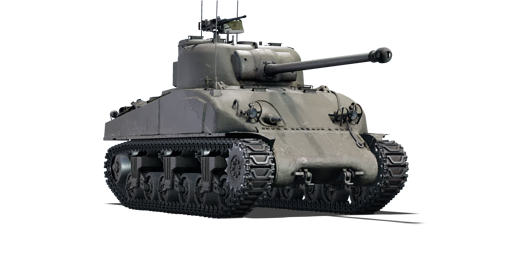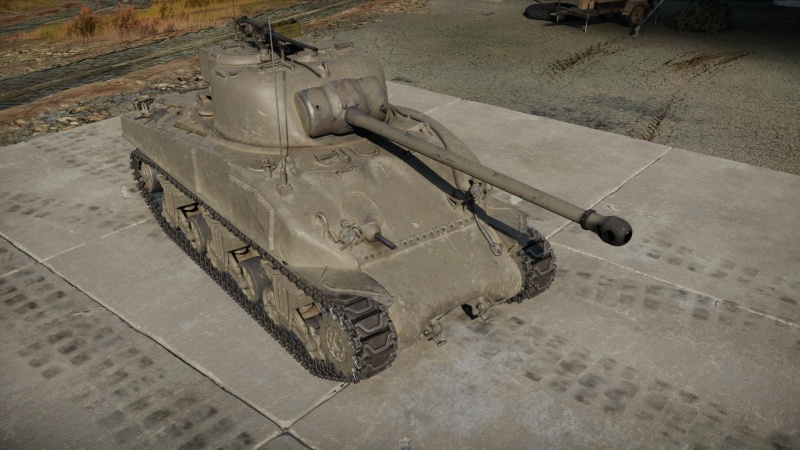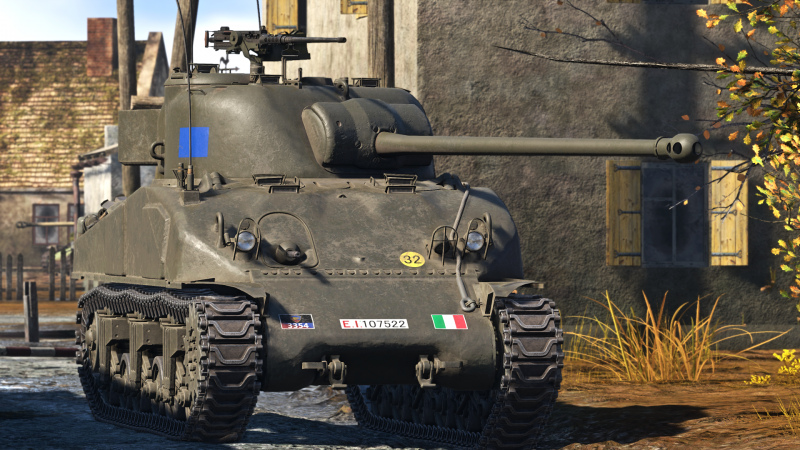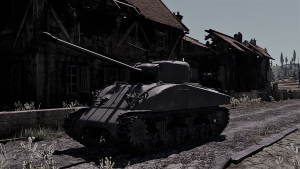Difference between revisions of "Sherman Ic"
(Tag: Visual edit) |
m (U38088265 moved page M4 Tipo IC to Sherman Ic: Renamed in 2.35) |
||
| (53 intermediate revisions by 17 users not shown) | |||
| Line 1: | Line 1: | ||
| − | |||
{{About | {{About | ||
| about = Italian medium tank '''{{PAGENAME}}''' | | about = Italian medium tank '''{{PAGENAME}}''' | ||
| − | | usage = other uses | + | | other |
| − | | link = M4 (Disambiguation) | + | | usage-1 = other versions |
| + | | link-1 = M4 Sherman (Family) | ||
| + | | usage-2 = other uses | ||
| + | | link-2 = M4 (Disambiguation) | ||
| + | }} | ||
| + | {{Specs-Card | ||
| + | |code=it_sherman_VII | ||
| + | |images={{Specs-Card-Image|GarageImage_{{PAGENAME}}.jpg|ArtImage_{{PAGENAME}}.png}} | ||
}} | }} | ||
== Description == | == Description == | ||
| − | <!--''In the description, the first part | + | <!-- ''In the description, the first part should be about the history of the creation and combat usage of the vehicle, as well as its key features. In the second part, tell the reader about the ground vehicle in the game. Insert a screenshot of the vehicle, so that if the novice player does not remember the vehicle by name, he will immediately understand what kind of vehicle the article is talking about.'' --> |
| − | [[ | + | The '''M4 Hybrid (Composito) Sherman IC Firefly''' is an up-gunned modification of the [[M4 Hybrid (Italy)|M4 Hybrid]], which is the special combination of the first and second variants of the early-generation [[M4 Sherman (Family)|Medium Tank M4 (Sherman) family]]. The turret of the original [[Sherman Firefly|M4A4 Sherman VC Firefly]] is directly mounted on an [[M4 Hybrid (Italy)|M4 Hybrid variant]] hull rather than the regular [[M4A4 (Italy)|M4A4 variant]] hull, making it a very distinctive derivative of the M4A4 Sherman IC Firefly. This is a unique tank that served mostly with the Italian Army and is armed with the powerful 76 mm Ordnance QF 17-pounder tank gun. Due to the scarcity of historical information on this vehicle, it is unknown to what extent this unique derivation of the famed "firefly" truly engaged in World War II. Following the reconstruction of Italy in 1945, some M4 Hybrid (Composito) Sherman IC Firefly tanks were transported to the country and redesignated as M4 Tipo IC Composito. A minor military command for the territorial defence was founded in 1946, and the unit received numerous other M4 Sherman variants. They laid the groundwork for Italy's first post-war tanker training school. All M4 Sherman variants were formally decommissioned in 1952. |
| − | + | ||
| − | + | Introduced in [[Update 1.85 "Supersonic"]], the M4 Tipo IC Composito in the Italian Army ground forces is comparable to its British counterpart, as it was delivered by the British Army after World War II to aid in the reconstruction of Italy and the development of a territory defence force. The M4 Tipo IC Composito, armed with the renowned 76 mm Ordnance QF 17-pounder tank gun, will provide players with an extremely substantial increase in firepower above the early variants of the M4 Sherman used by the Italian Army ground forces, which were equipped with the 75 mm M3 tank gun. The M4 Tipo IC Composito, along with the M4A4 Sherman VC Firefly, will form the major backbone of the Italian Army's ground forces; however, it lacks access to armour-piercing discarding sabot (APDS) ammunition, which the latter has. | |
== General info == | == General info == | ||
=== Survivability and armour === | === Survivability and armour === | ||
| − | ''Describe armour protection. Note the most well protected and key weak areas. Appreciate the layout of modules as well as the number and location of crew members. Is the level of armour protection sufficient, is the placement of modules helpful for survival in combat?'' | + | {{Specs-Tank-Armour}} |
| + | <!-- ''Describe armour protection. Note the most well protected and key weak areas. Appreciate the layout of modules as well as the number and location of crew members. Is the level of armour protection sufficient, is the placement of modules helpful for survival in combat? If necessary use a visual template to indicate the most secure and weak zones of the armour.'' --> | ||
| + | |||
| + | '''Armour type:''' | ||
| − | ''If | + | * Cast homogeneous armour (Hull Front, turret, turret cupola) |
| + | * Rolled homogeneous armour (Hull sides, rear and roof, add-on bustle, turret roof) | ||
| + | |||
| + | {| class="wikitable" | ||
| + | |- | ||
| + | ! Armour !! Front (Slope angle) !! Sides !! Rear !! Roof | ||
| + | |- | ||
| + | | Hull || 50.8 mm (8-74°) ''Upper Glacis'' <br> 50.8 mm (2-59°) ''Lower Glacis'' || 38.1 mm ''Lower'' <br> 50.8 ''Upper Front'' <br> 38.1 ''Upper Rear'' || 38.1 mm || 50.8 mm ''Front'' <br> 19.05 mm ''Rear'' | ||
| + | |- | ||
| + | |Turret || 50 mm - 76.2 mm (Varying Angles) ''Turret Front'' <br> 38.1 + 38.1 mm (cylindrical) ''Gun mantlet'' || 50.8 mm || 63.5 mm ''Original Bustle'' <br> 63.5 mm ''Add-on Bustle'' || 25.4 mm ''Crew Compartment'' <br> 50.8 mm ''Original Bustle'' <br> 25.4 mm ''Add-on Bustle'' | ||
| + | |- | ||
| + | |Cupola || colspan="3" style="text-align:center" | 50.8 mm || 25.4 mm | ||
| + | |} | ||
| + | '''Notes:''' | ||
| + | |||
| + | * 25.4 mm Plates Cover Portions of the Hull Sides | ||
| + | * Tracks - 20 mm | ||
| + | * Suspension - 10 to 15 mm | ||
| + | * Fenders - 10 mm | ||
| + | * Main Gun - 20 mm | ||
| + | * Machine Guns - 10 mm | ||
| + | |||
| + | The {{PAGENAME}} has survivability similar to that of the American M4A1 Sherman. The armour is not strong for the battle rating and most enemies, save for SPAA, will go right through the front. If the tank is penetrated it is likely that at least two of the five crew will survive, depending on where the shot hits and how much HE filler it has. The gun breech is quite large, and it can often save the crew members on one side from the shrapnel of a penetration to the other side of the turret. Additionally, almost all the ammunition is stored in the hull floor, while a minority is stored in the turret basket; this means it is unlikely for the ammunition to explode under most circumstances. Despite these factors, almost every penetration will cause crippling damage - either immobilizing the tank or disabling the main gun, which allows the enemy to take a second finishing shot soon after. In summary, the survivability of the {{PAGENAME}} is not to be relied upon as it will rarely survive two shots and will almost never bounce a shot. As such, you should plan your route in order to avoid frontal engagements with the enemy. | ||
=== Mobility === | === Mobility === | ||
| + | {{Specs-Tank-Mobility}} | ||
<!-- ''Write about the mobility of the ground vehicle. Estimate the specific power and manoeuvrability, as well as the maximum speed forwards and backwards.'' --> | <!-- ''Write about the mobility of the ground vehicle. Estimate the specific power and manoeuvrability, as well as the maximum speed forwards and backwards.'' --> | ||
| − | {{tankMobility|abMinHp= 620|rbMinHp= 354}} | + | {{tankMobility|abMinHp=620|rbMinHp=354}} |
| + | |||
| + | === Modifications and economy === | ||
| + | {{Specs-Economy}} | ||
== Armaments == | == Armaments == | ||
| + | {{Specs-Tank-Armaments}} | ||
=== Main armament === | === Main armament === | ||
| − | <!--''Give the reader information about the characteristics of the main gun. Assess its effectiveness in a battle based on the reloading speed, ballistics and the power of shells. Do not forget about the flexibility of the fire, that is how quickly the cannon can be aimed at the target, open fire on it and aim at another enemy. Add a link to the main article on the gun: <code><nowiki>{{main|Name of the weapon}}</nowiki></code>. Describe in general terms the ammunition available for the main gun. Give advice on how to use them and how to fill the ammunition storage.''--> | + | {{Specs-Tank-Weapon|1}} |
| + | <!-- ''Give the reader information about the characteristics of the main gun. Assess its effectiveness in a battle based on the reloading speed, ballistics and the power of shells. Do not forget about the flexibility of the fire, that is how quickly the cannon can be aimed at the target, open fire on it and aim at another enemy. Add a link to the main article on the gun: <code><nowiki>{{main|Name of the weapon}}</nowiki></code>. Describe in general terms the ammunition available for the main gun. Give advice on how to use them and how to fill the ammunition storage.'' --> | ||
| + | {{main|QF 17-pounder (76 mm)}} | ||
| + | |||
| + | {| class="wikitable" style="text-align:center" width="100%" | ||
| + | |- | ||
| + | ! colspan="5" | [[QF 17-pounder (76 mm)|76 mm QF 17-pounder]] || colspan="5" | Turret rotation speed (°/s) || colspan="4" | Reloading rate (seconds) | ||
| + | |- | ||
| + | ! Mode !! Capacity !! Vertical !! Horizontal !! Stabilizer | ||
| + | ! Stock !! Upgraded !! Full !! Expert !! Aced | ||
| + | ! Stock !! Full !! Expert !! Aced | ||
| + | |- | ||
| + | ! ''Arcade'' | ||
| + | | rowspan="2" | 65 || rowspan="2" | -5°/+25° || rowspan="2" | ±180° || rowspan="2" | N/A || 22.8 || 31.6 || 38.4 || 42.5 || 45.2 || rowspan="2" | 7.67 || rowspan="2" | 6.79 || rowspan="2" | 6.25 || rowspan="2" | 5.90 | ||
| + | |- | ||
| + | ! ''Realistic'' | ||
| + | | 14.3 || 16.8 || 20.4 || 22.6 || 24.0 | ||
| + | |- | ||
| + | |} | ||
| + | |||
| + | ==== Ammunition ==== | ||
| + | {{:QF 17-pounder (76 mm)/Ammunition|Shot Mk.6, Shell Mk.1, Shot Mk.4, Shot Mk.8, 17pdr Shell SS Mk.1}} | ||
| − | + | ==== [[Ammo racks]] ==== | |
| + | [[File:Ammoracks_{{PAGENAME}}.png|right|thumb|x250px|[[Ammo racks]] of the {{PAGENAME}}]] | ||
| + | <!-- '''Last updated: 2.17.0.42''' --> | ||
| + | {| class="wikitable" style="text-align:center" | ||
| + | |- | ||
| + | ! Full<br>ammo | ||
| + | ! 1st<br>rack empty | ||
| + | ! 2nd<br>rack empty | ||
| + | ! 3rd<br>rack empty | ||
| + | ! 4th<br>rack empty | ||
| + | ! 5th<br>rack empty | ||
| + | ! Visual<br>discrepancy | ||
| + | |- | ||
| + | | '''65''' || 46 ''(+19)'' || 26 ''(+39)'' || 6 ''(+59)'' || 4 ''(+61)'' || 1 ''(+64)'' || No | ||
| + | |- | ||
| + | |} | ||
| + | '''Note''': | ||
| − | + | * Shells are modeled individually and disappear from the rack after having been shot or loaded. | |
| − | |||
=== Machine guns === | === Machine guns === | ||
| − | ''Offensive and anti-aircraft machine guns not only allow you to fight some aircraft | + | {{Specs-Tank-Weapon|2}} |
| + | {{Specs-Tank-Weapon|3}} | ||
| + | <!-- ''Offensive and anti-aircraft machine guns not only allow you to fight some aircraft but also are effective against lightly armoured vehicles. Evaluate machine guns and give recommendations on its use.'' --> | ||
| + | {{main|M2HB (12.7 mm)|L3A1 (7.62 mm)}} | ||
| + | |||
| + | {| class="wikitable" style="text-align:center" width="50%" | ||
| + | |- | ||
| + | ! colspan="5" | [[M2HB (12.7 mm)|12.7 mm M2HB]] | ||
| + | |- | ||
| + | ! Mount !! Capacity (Belt) !! Fire rate !! Vertical !! Horizontal | ||
| + | |- | ||
| + | | Pintle || 800 (200) || 577 || -10°/+15° || ±180° | ||
| + | |- | ||
| + | |} | ||
| + | |||
| + | The roof-mounted Browning .50 cal heavy machine gun is very good at knocking out tracks, punching through lightly armoured vehicles and shooting down low-flying aircraft. | ||
| + | |||
| + | {| class="wikitable" style="text-align:center" width="50%" | ||
| + | |- | ||
| + | ! colspan="5" | [[L3A1 (7.62 mm)|7.62 mm L3A1]] | ||
| + | |- | ||
| + | ! Mount !! Capacity (Belt) !! Fire rate !! Vertical !! Horizontal | ||
| + | |- | ||
| + | | Coaxial || 5,000 (250) || 500 || N/A || N/A | ||
| + | |- | ||
| + | |} | ||
| + | |||
| + | The small calibre of the L3A1 machine gun makes it largely ineffective against all armoured vehicles but the ones with an open compartment. It still can be used to ping targets as a rangefinding help or to mow down minor obstacles blocking your line of sight. | ||
| + | A second hull-mounted .30 cal machine gun is modeled but not usable. | ||
== Usage in battles == | == Usage in battles == | ||
| − | ''Describe the tactics of playing in the vehicle, the features of using vehicles in the team and advice on tactics. Refrain from creating a "guide" - do not impose a single point of view but give the reader food for thought. Describe the most dangerous enemies and give recommendations on fighting them. If necessary, note the specifics of the game in different modes (AB, RB, SB).'' | + | <!-- ''Describe the tactics of playing in the vehicle, the features of using vehicles in the team and advice on tactics. Refrain from creating a "guide" - do not impose a single point of view but instead give the reader food for thought. Describe the most dangerous enemies and give recommendations on fighting them. If necessary, note the specifics of the game in different modes (AB, RB, SB).'' --> |
| + | |||
| + | The {{PAGENAME}} is almost identical to the British Sherman Firefly, with minor cosmetic differences, an additional crew member, and a weaker overall gun mantlet. The player can be confidently rely on the mighty 17-pounder gun to effectively neutralize other tanks regardless of the angles (including the frontal armour of the Tiger or the T-34s). It excels at sniping from a distance and can also can spearhead an attack if needed. | ||
| + | |||
| + | '''Enemies worth noting:''' | ||
| + | |||
| + | R3 T20 FA-HS (AB): | ||
| + | |||
| + | This speedy wheeled vehicle can circle around you with ease and wipe out all your crew with its fast firing autocannon. In a close encounter, never expose your side to it, and do not even angle your hull. Face your hull directly to the R3, because on each side of the cast hull, above the inducer wheel there is a triangular area that blends and connects the upper front plate to the side. By angling the hull, this triangle becomes unangled to the R3, making it easily penetrated, and the driver / gunner will usually get knocked out first. It is harder for the R3 to penetrate your unangled hull thus giving you more time to react and destroy it. | ||
=== Pros and cons === | === Pros and cons === | ||
| − | <!-- | + | <!-- ''Summarise and briefly evaluate the vehicle in terms of its characteristics and combat effectiveness. Mark its pros and cons in a bulleted list. Try not to use more than 6 points for each of the characteristics. Avoid using categorical definitions such as "bad", "good" and the like - use substitutions with softer forms such as "inadequate" and "effective".'' --> |
| + | |||
'''Pros:''' | '''Pros:''' | ||
| − | * | + | * Powerful British 17-pdr gun |
| − | * Has a .50 cal for | + | * Has a .50 cal HMG for defence against aircraft |
| − | * Good mobility, as with all | + | * Good mobility, as with all Shermans |
| + | * Cast hull does not have the thin armour weak spots of the M4A1 | ||
'''Cons:''' | '''Cons:''' | ||
| − | * | + | * Armour can be penetrated by most enemies at its battle rating |
| − | * No HE | + | * No HE filler in any of its AP shells, meaning that a shot either has to detonate the ammo rack of a target or generate enough spalling to take out the tank |
* .50 cal machine gun can't elevate very high; can only engage low-flying aircraft | * .50 cal machine gun can't elevate very high; can only engage low-flying aircraft | ||
| + | * Poor gun depression of only -5° | ||
== History == | == History == | ||
| + | <!-- ''Describe the history of the creation and combat usage of the vehicle in more detail than in the introduction. If the historical reference turns out to be too long, take it to a separate article, taking a link to the article about the vehicle and adding a block "/History" (example: <nowiki>https://wiki.warthunder.com/(Vehicle-name)/History</nowiki>) and add a link to it here using the <code>main</code> template. Be sure to reference text and sources by using <code><nowiki><ref></ref></nowiki></code>, as well as adding them at the end of the article with <code><nowiki><references /></nowiki></code>. This section may also include the vehicle's dev blog entry (if applicable) and the in-game encyclopedia description (under <code><nowiki>=== In-game description ===</nowiki></code>, also if applicable).'' --> | ||
| − | + | {{main|Sherman_Firefly#History|l1=History of the Sherman Firefly}} | |
| − | |||
| − | + | === In Italian Service === | |
| + | [[File:M4 Tipo IC .png|thumb|Impression of an M4 Tipo IC on parade]] | ||
| + | The Firefly first saw action in Italy in British, American, and Polish hands in the Italian Campaign in 1944, but were ceased since heavy German armour proved to be a challenging opponent for the Firefly. After WW2, Italy was supplied with tanks by the US and UK, such as the [[Sherman Firefly]] (designated as M4 Tipo IC or [[Sherman Vc (Italy)|M4 Tipo VC]] depending on the variant) and [[M24 (Italy)|M24 Chaffee]], which were commissioned in 1947. At that time, Italy created the first nucleus for the formation of a tankers school and on the 1st of October officially formed the Military School Organization. | ||
| − | + | The M4 Tipo ICs were decommissioned and scrapped in 1952. | |
| − | |||
| − | '' | + | == Media == |
| + | <!-- ''Excellent additions to the article would be video guides, screenshots from the game, and photos.'' --> | ||
| − | + | ;Skins | |
| − | + | * [https://live.warthunder.com/feed/camouflages/?vehicle=it_sherman_VII Skins and camouflages for the {{PAGENAME}} from live.warthunder.com.] | |
| − | |||
| − | + | ;Images | |
| − | + | [[File:The British Army in the Normandy Campaign 1944 .jpg|thumb|none|350px|<small>A British Firefly during the Normandy Campaign 1944<ref>http://www.theshermantank.com/sherman/the-firefly-the-teapot-with-teeth/</ref></small>]] | |
| − | '' | + | ;Videos |
| + | {{Youtube-gallery|Ege0ylN0RCA|'''Lookback: {{PAGENAME}}''' - ''Orangefan''|YK_kiOv7cJo|'''{{PAGENAME}} Composito, Italian, Tier-3, Medium Tank''' - ''Angry Nerd Gaming''}} | ||
| − | == | + | == See also == |
| − | + | <!-- ''Links to the articles on the War Thunder Wiki that you think will be useful for the reader, for example:'' | |
| − | + | * ''reference to the series of the vehicles;'' | |
| − | '' | + | * ''links to approximate analogues of other nations and research trees.'' --> |
| − | + | ;Vehicles equipped with the same gun & turret | |
| − | + | * [[Sherman Firefly]] | |
| + | * [[Sherman IC "Trzyniec"]] | ||
| + | * [[Sherman Vc (Italy)]] | ||
| − | + | ;Other vehicles of similar configuration and role | |
| − | |||
| − | + | * [[M4A1 (76) W]] | |
| − | + | * [[M4A4 (SA50)]] | |
| − | |||
| − | * | ||
| − | * | ||
== External links == | == External links == | ||
| − | ''Paste links to sources and external resources, such as:'' | + | <!-- ''Paste links to sources and external resources, such as:'' |
| + | * ''topic on the official game forum;'' | ||
| + | * ''other literature.'' --> | ||
| − | + | === References === | |
| − | + | <references /> | |
| − | |||
| + | {{TankManufacturer Department of Tank Design}} | ||
{{Italy medium tanks}} | {{Italy medium tanks}} | ||
Latest revision as of 15:44, 13 March 2024
| This page is about the Italian medium tank Sherman Ic. For other versions, see M4 Sherman (Family). For other uses, see M4 (Disambiguation). |
Contents
Description
The M4 Hybrid (Composito) Sherman IC Firefly is an up-gunned modification of the M4 Hybrid, which is the special combination of the first and second variants of the early-generation Medium Tank M4 (Sherman) family. The turret of the original M4A4 Sherman VC Firefly is directly mounted on an M4 Hybrid variant hull rather than the regular M4A4 variant hull, making it a very distinctive derivative of the M4A4 Sherman IC Firefly. This is a unique tank that served mostly with the Italian Army and is armed with the powerful 76 mm Ordnance QF 17-pounder tank gun. Due to the scarcity of historical information on this vehicle, it is unknown to what extent this unique derivation of the famed "firefly" truly engaged in World War II. Following the reconstruction of Italy in 1945, some M4 Hybrid (Composito) Sherman IC Firefly tanks were transported to the country and redesignated as M4 Tipo IC Composito. A minor military command for the territorial defence was founded in 1946, and the unit received numerous other M4 Sherman variants. They laid the groundwork for Italy's first post-war tanker training school. All M4 Sherman variants were formally decommissioned in 1952.
Introduced in Update 1.85 "Supersonic", the M4 Tipo IC Composito in the Italian Army ground forces is comparable to its British counterpart, as it was delivered by the British Army after World War II to aid in the reconstruction of Italy and the development of a territory defence force. The M4 Tipo IC Composito, armed with the renowned 76 mm Ordnance QF 17-pounder tank gun, will provide players with an extremely substantial increase in firepower above the early variants of the M4 Sherman used by the Italian Army ground forces, which were equipped with the 75 mm M3 tank gun. The M4 Tipo IC Composito, along with the M4A4 Sherman VC Firefly, will form the major backbone of the Italian Army's ground forces; however, it lacks access to armour-piercing discarding sabot (APDS) ammunition, which the latter has.
General info
Survivability and armour
Armour type:
- Cast homogeneous armour (Hull Front, turret, turret cupola)
- Rolled homogeneous armour (Hull sides, rear and roof, add-on bustle, turret roof)
| Armour | Front (Slope angle) | Sides | Rear | Roof |
|---|---|---|---|---|
| Hull | 50.8 mm (8-74°) Upper Glacis 50.8 mm (2-59°) Lower Glacis |
38.1 mm Lower 50.8 Upper Front 38.1 Upper Rear |
38.1 mm | 50.8 mm Front 19.05 mm Rear |
| Turret | 50 mm - 76.2 mm (Varying Angles) Turret Front 38.1 + 38.1 mm (cylindrical) Gun mantlet |
50.8 mm | 63.5 mm Original Bustle 63.5 mm Add-on Bustle |
25.4 mm Crew Compartment 50.8 mm Original Bustle 25.4 mm Add-on Bustle |
| Cupola | 50.8 mm | 25.4 mm | ||
Notes:
- 25.4 mm Plates Cover Portions of the Hull Sides
- Tracks - 20 mm
- Suspension - 10 to 15 mm
- Fenders - 10 mm
- Main Gun - 20 mm
- Machine Guns - 10 mm
The Sherman Ic has survivability similar to that of the American M4A1 Sherman. The armour is not strong for the battle rating and most enemies, save for SPAA, will go right through the front. If the tank is penetrated it is likely that at least two of the five crew will survive, depending on where the shot hits and how much HE filler it has. The gun breech is quite large, and it can often save the crew members on one side from the shrapnel of a penetration to the other side of the turret. Additionally, almost all the ammunition is stored in the hull floor, while a minority is stored in the turret basket; this means it is unlikely for the ammunition to explode under most circumstances. Despite these factors, almost every penetration will cause crippling damage - either immobilizing the tank or disabling the main gun, which allows the enemy to take a second finishing shot soon after. In summary, the survivability of the Sherman Ic is not to be relied upon as it will rarely survive two shots and will almost never bounce a shot. As such, you should plan your route in order to avoid frontal engagements with the enemy.
Mobility
| Game Mode | Max Speed (km/h) | Weight (tons) | Engine power (horsepower) | Power-to-weight ratio (hp/ton) | |||
|---|---|---|---|---|---|---|---|
| Forward | Reverse | Stock | Upgraded | Stock | Upgraded | ||
| Arcade | 43 | 6 | 31.5 | 620 | 763 | 19.68 | 24.22 |
| Realistic | 38 | 5 | 354 | 400 | 11.24 | 12.7 | |
Modifications and economy
Armaments
Main armament
| 76 mm QF 17-pounder | Turret rotation speed (°/s) | Reloading rate (seconds) | |||||||||||
|---|---|---|---|---|---|---|---|---|---|---|---|---|---|
| Mode | Capacity | Vertical | Horizontal | Stabilizer | Stock | Upgraded | Full | Expert | Aced | Stock | Full | Expert | Aced |
| Arcade | 65 | -5°/+25° | ±180° | N/A | 22.8 | 31.6 | 38.4 | 42.5 | 45.2 | 7.67 | 6.79 | 6.25 | 5.90 |
| Realistic | 14.3 | 16.8 | 20.4 | 22.6 | 24.0 | ||||||||
Ammunition
| Penetration statistics | |||||||
|---|---|---|---|---|---|---|---|
| Ammunition | Type of warhead |
Penetration @ 0° Angle of Attack (mm) | |||||
| 10 m | 100 m | 500 m | 1,000 m | 1,500 m | 2,000 m | ||
| Shot Mk.6 | AP | 171 | 168 | 155 | 139 | 126 | 113 |
| Shell Mk.1 | HE | 20 | 20 | 18 | 16 | 15 | 13 |
| Shot Mk.4 | APC | 171 | 168 | 155 | 139 | 126 | 113 |
| Shot Mk.8 | APCBC | 190 | 187 | 172 | 155 | 140 | 126 |
| Shell details | ||||||||||||
|---|---|---|---|---|---|---|---|---|---|---|---|---|
| Ammunition | Type of warhead |
Velocity (m/s) |
Projectile mass (kg) |
Fuse delay (m) |
Fuse sensitivity (mm) |
Explosive mass (TNT equivalent) (g) |
Ricochet | |||||
| 0% | 50% | 100% | ||||||||||
| Shot Mk.6 | AP | 883 | 7.71 | - | - | - | 47° | 60° | 65° | |||
| Shell Mk.1 | HE | 883 | 6.98 | 0.2 | 0.1 | 580 | 79° | 80° | 81° | |||
| Shot Mk.4 | APC | 883 | 7.71 | - | - | - | 48° | 63° | 71° | |||
| Shot Mk.8 | APCBC | 883 | 7.71 | - | - | - | 48° | 63° | 71° | |||
| Smoke shell characteristics | ||||||
|---|---|---|---|---|---|---|
| Ammunition | Velocity (m/s) |
Projectile mass (kg) |
Screen radius (m) |
Screen deploy time (s) |
Screen hold time (s) |
Explosive mass (TNT equivalent) (g) |
| 17pdr Shell SS Mk.1 | 229 | 8.44 | 13 | 5 | 20 | 50 |
Ammo racks
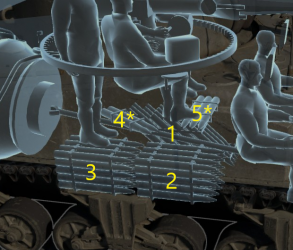
| Full ammo |
1st rack empty |
2nd rack empty |
3rd rack empty |
4th rack empty |
5th rack empty |
Visual discrepancy |
|---|---|---|---|---|---|---|
| 65 | 46 (+19) | 26 (+39) | 6 (+59) | 4 (+61) | 1 (+64) | No |
Note:
- Shells are modeled individually and disappear from the rack after having been shot or loaded.
Machine guns
| 12.7 mm M2HB | ||||
|---|---|---|---|---|
| Mount | Capacity (Belt) | Fire rate | Vertical | Horizontal |
| Pintle | 800 (200) | 577 | -10°/+15° | ±180° |
The roof-mounted Browning .50 cal heavy machine gun is very good at knocking out tracks, punching through lightly armoured vehicles and shooting down low-flying aircraft.
| 7.62 mm L3A1 | ||||
|---|---|---|---|---|
| Mount | Capacity (Belt) | Fire rate | Vertical | Horizontal |
| Coaxial | 5,000 (250) | 500 | N/A | N/A |
The small calibre of the L3A1 machine gun makes it largely ineffective against all armoured vehicles but the ones with an open compartment. It still can be used to ping targets as a rangefinding help or to mow down minor obstacles blocking your line of sight. A second hull-mounted .30 cal machine gun is modeled but not usable.
Usage in battles
The Sherman Ic is almost identical to the British Sherman Firefly, with minor cosmetic differences, an additional crew member, and a weaker overall gun mantlet. The player can be confidently rely on the mighty 17-pounder gun to effectively neutralize other tanks regardless of the angles (including the frontal armour of the Tiger or the T-34s). It excels at sniping from a distance and can also can spearhead an attack if needed.
Enemies worth noting:
R3 T20 FA-HS (AB):
This speedy wheeled vehicle can circle around you with ease and wipe out all your crew with its fast firing autocannon. In a close encounter, never expose your side to it, and do not even angle your hull. Face your hull directly to the R3, because on each side of the cast hull, above the inducer wheel there is a triangular area that blends and connects the upper front plate to the side. By angling the hull, this triangle becomes unangled to the R3, making it easily penetrated, and the driver / gunner will usually get knocked out first. It is harder for the R3 to penetrate your unangled hull thus giving you more time to react and destroy it.
Pros and cons
Pros:
- Powerful British 17-pdr gun
- Has a .50 cal HMG for defence against aircraft
- Good mobility, as with all Shermans
- Cast hull does not have the thin armour weak spots of the M4A1
Cons:
- Armour can be penetrated by most enemies at its battle rating
- No HE filler in any of its AP shells, meaning that a shot either has to detonate the ammo rack of a target or generate enough spalling to take out the tank
- .50 cal machine gun can't elevate very high; can only engage low-flying aircraft
- Poor gun depression of only -5°
History
In Italian Service
The Firefly first saw action in Italy in British, American, and Polish hands in the Italian Campaign in 1944, but were ceased since heavy German armour proved to be a challenging opponent for the Firefly. After WW2, Italy was supplied with tanks by the US and UK, such as the Sherman Firefly (designated as M4 Tipo IC or M4 Tipo VC depending on the variant) and M24 Chaffee, which were commissioned in 1947. At that time, Italy created the first nucleus for the formation of a tankers school and on the 1st of October officially formed the Military School Organization.
The M4 Tipo ICs were decommissioned and scrapped in 1952.
Media
- Skins
- Images
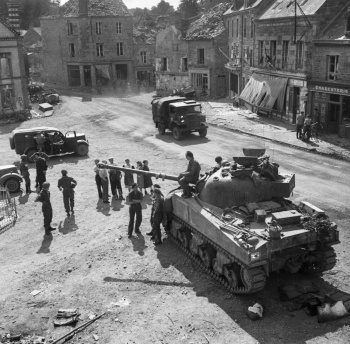
- Videos
See also
- Vehicles equipped with the same gun & turret
- Other vehicles of similar configuration and role
External links
References
| Department of Tank Design | |
|---|---|
| Medium Tanks | |
| Sherman Firefly | Sherman Firefly · Sherman IC "Trzyniec" |
| MBTs | |
| Centurion | Centurion Mk 1 · Centurion Mk.2 · Centurion Mk 3 · Centurion Action X · Centurion Mk.5 AVRE · Centurion Mk 10 |
| Challenger* | Challenger Mk.2 · Challenger Mk.3 · Challenger DS |
| Tank Destroyers | |
| Achilles | Achilles · Achilles (65 Rg.) |
| Centurion-based | Conway · FV4005 |
| Export | |
| Sherman Firefly | Sherman Ic · ▄Sherman Vc |
| Centurion | Centurion Mk.5/1 · Strv 81 · Strv 81 (RB 52) · ▄Strv 81 (RB 52) · Strv 101 · Strv 104** · Strv 105** · Sho't |
| See also | US Ordnance Department · Israeli Ordnance Corps · Vickers-Armstrongs Limited |
| *By successor, the Military Vehicles and Engineering Establishment | |
| **Swedish modernizations incorporating innovations from the Israeli Sho't Kals. | |
| Italy medium tanks | |
|---|---|
| Italy | |
| M13/40 | M13/40 (I) · M13/40 (II) · M13/40 (III) |
| M14/41 | M14/41 · M14/41 (47/40) |
| M15/42 | M15/42 |
| M16/43 | Celere Sahariano |
| P26/40 | P40 · P40 "G.C. Leoncello" |
| OF-40 | OF-40 · OF-40 Mk.2A · OF-40 (MTCA) |
| Ariete | Ariete (P) · Ariete · Ariete PSO · Ariete AMV |
| Germany | ▄Pz.III N · ▄Pz.IV G · ▄Leopard 1A5 |
| Allied powers | ▄Sherman I Composito · Sherman Ic · ▄Sherman Vc · ▄Sherman V · M26 "D.C.Ariete" · M26A1 · M47 (105/55) · M60A1 "D.C.Ariete" |
| Hungary | |
| Turán | Turan I · Turan II · Turan III |
| Germany | ◔Leopard 2A4 |
| USSR | ◔T-72M1 |


